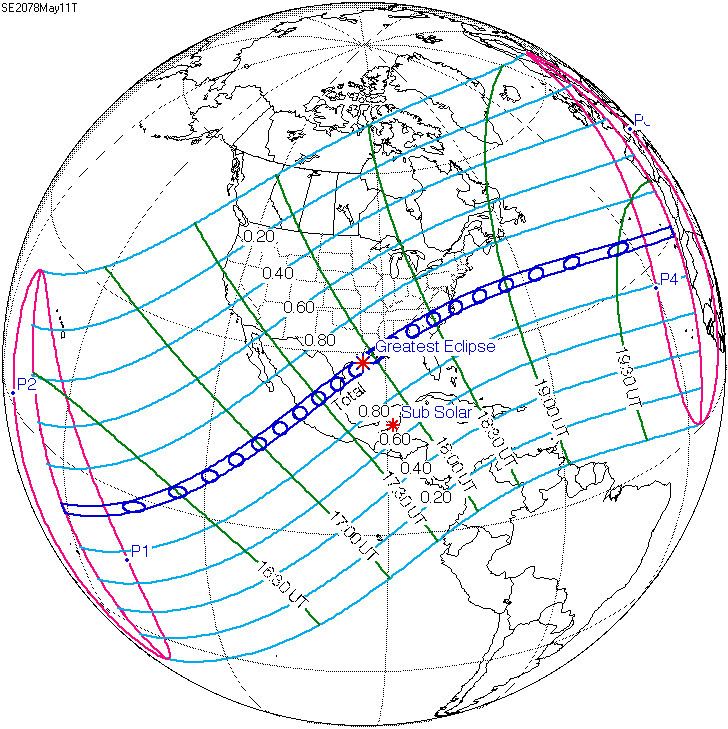Nature Total Magnitude 1.0701 Max. width of band 232 km (144 mi) Start date May 11, 2078 | Gamma 0.1838 Duration 340 sec (5 m 40 s) Greatest eclipse 17:56:55 | |
 | ||
A total solar eclipse will occur on May 11, 2078. A solar eclipse occurs when the Moon passes between Earth and the Sun, thereby totally or partly obscuring the image of the Sun for a viewer on Earth. A total solar eclipse occurs when the Moon's apparent diameter is larger than the Sun's, blocking all direct sunlight, turning day into darkness. Totality occurs in a narrow path across Earth's surface, with the partial solar eclipse visible over a surrounding region thousands of kilometres wide.
Contents
Solar eclipses 2076-2079
Each member in a semester series of solar eclipses repeats approximately every 177 days and 4 hours (a semester) at alternating nodes of the Moon's orbit.
Saros 139
It is a part of saros series 139, repeating every 18 years, 11 days, containing 71 events. The series started with partial solar eclipse on May 17, 1501. It contains hybrid eclipses on August 11, 1627 through December 9, 1825 and total eclipses from December 21, 1843 through March 26, 2601. The series ends at member 71 as a partial eclipse on July 3, 2763. Members in the same column are one exeligmos apart and thus occur in the same geographic area.
The solar eclipse of June 13, 2132 will be the longest total solar eclipse since July 11, 1991 at 6 minutes, 55 seconds.
The longest duration of totality will be produced by member 39 at 7 minutes, 29 seconds on July 16, 2186. This is the longest solar eclipse computed between 4000BC and 6000AD.
Inex series
This eclipse is a part of the long period inex cycle, repeating at alternating nodes, every 358 synodic months (≈ 10,571.95 days, or 29 years minus 20 days). Their appearance and longitude are irregular due to a lack of synchronization with the anomalistic month (period of perigee). However, groupings of 3 inex cycles (≈ 87 years minus 2 months) comes close (≈ 1,151.02 anomalistic months), so eclipses are similar in these groupings.
Inex series
This eclipse is a part of the long period inex cycle, repeating at alternating nodes, every 358 synodic months (≈ 10,571.95 days, or 29 years minus 20 days). Their appearance and longitude are irregular due to a lack of synchronization with the anomalistic month (period of perigee). However, groupings of 3 inex cycles (≈ 87 years minus 2 months) comes close (≈ 1,151.02 anomalistic months), so eclipses are similar in these groupings.
